Modak, Laddu, Hibiscus & what not! Here's why these things are Bhagwan Ganesha's favourites;
18 Sep 2023 12:54:25
In Hindu mythology, Bhagwan Ganesha is believed to have certain favorite items or offerings that are often presented to him during worship or as a sign of devotion. Besides, these things have spiritual significance as symbolism plays a very significant role in Hindu Dharma. On the occasion of Ganesha Chaturthi, it is important to understand the spiritual significance that we as humanity can relate with these things that are so liked by the god of wisdom, Bhagwan Ganesha.
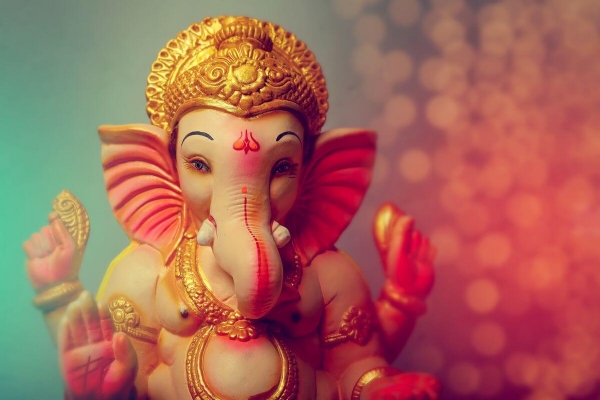
Symbolism in Hindu Dharma is paramount, serving as a bridge between the finite and infinite. Icons, rituals, and sacred imagery convey profound spiritual concepts, making abstract ideas accessible to devotees. Symbols like the lotus symbolize purity and enlightenment, while the OM represents the essence of creation. The third eye signifies inner perception and intuition. These symbols enrich religious practices, fostering devotion, and connecting individuals with the divine. They help transcend the limitations of language and rational thought, providing a visual and experiential means to access spiritual truths, deepening one's understanding of the cosmos and one's place within it.
Here are six things that are considered to be Bhagwan Ganesha's favorites:
1. Modak -
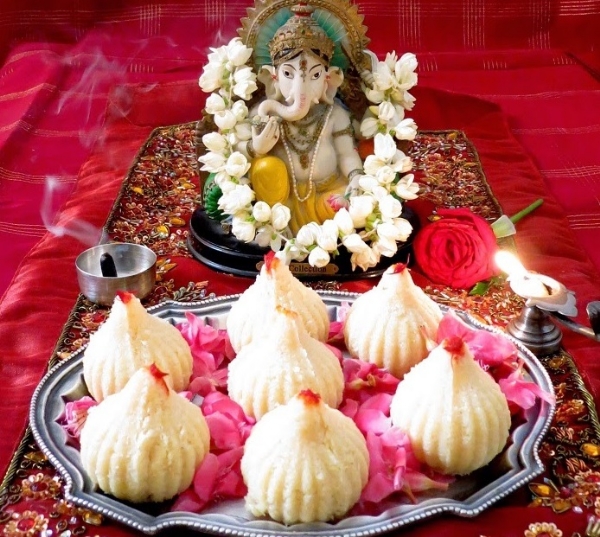
Modak is a sweet dumpling made from rice flour or wheat flour, stuffed with jaggery and coconut, and steamed or fried. It is widely regarded as Bhagwan Ganesha's favorite food, and it is often offered to him during festivals and prayers.
Symbolism: Modak is considered Bhagwan Ganesha's favorite food because it symbolizes wisdom and intelligence. Its round shape represents the universe, and the sweet filling inside represents the inherent sweetness of knowledge.
Spiritual Significance: Offering modaks to Bhagwan Ganesha signifies a desire for wisdom and understanding, seeking his blessings to remove obstacles on the path to knowledge.
2. Laddu:
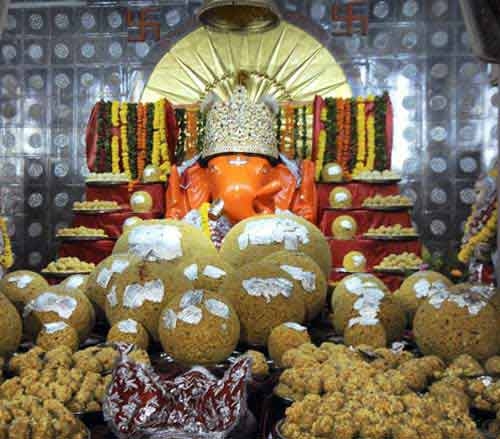
Laddu is a round sweet made from various ingredients such as gram flour, semolina, or ground chickpeas, mixed with sugar and ghee (clarified butter). Bhagwan Ganesha is known to have a sweet tooth, and laddus are a popular sweet offered to him.
Symbolism: Laddu represents the sweetness of devotion and the rewards of spiritual practice. Its round shape signifies completeness and unity.
Spiritual Significance: Offering laddus to Bhagwan Ganesha symbolizes devotion, seeking his blessings to overcome life's challenges and experience the sweetness of a harmonious and fulfilled life.
3. Red Hibiscus Flowers -
Red hibiscus flowers are considered sacred and are often used in the worship of Bhagwan Ganesha. He is said to be fond of the vibrant red color of these flowers, and they are offered to him as garlands or as part of his decoration.
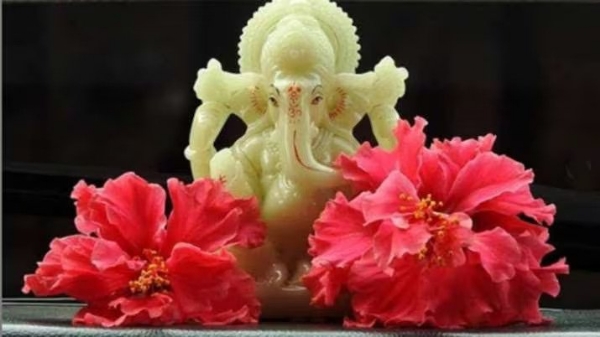
Symbolism: Red hibiscus flowers symbolize purity, auspiciousness, and the vibrant energy of life. Red is often associated with passion and love.
Spiritual Significance: Offering red hibiscus flowers to Bhagwan Ganesha represents the devotion and love of his devotees. The bright red color signifies the fervent desire for spiritual growth and success in endeavors.
4. Durva Grass:
Durva grass, also known as Bermuda grass, is believed to be dear to Bhagwan Ganesha. It is common to offer a three-bladed tuft of durva grass while invoking his blessings or performing rituals in his honor.
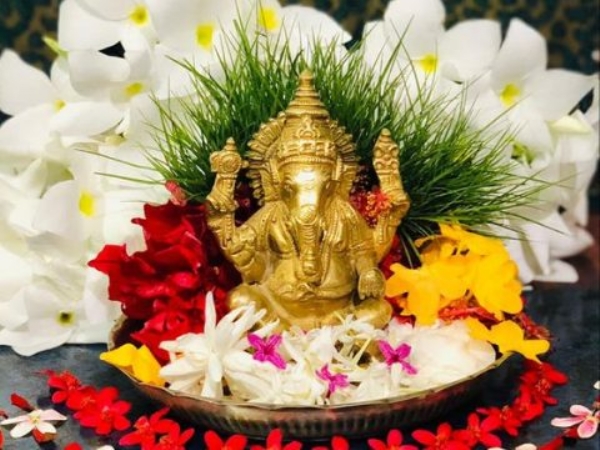
Symbolism: Durva grass symbolizes the ability to overcome obstacles and challenges. Its three blades are associated with the three primary qualities of nature (guna) in Hindu philosophy: sattva (goodness), rajas (passion), and tamas (ignorance).
Spiritual Significance: Offering durva grass to Bhagwan Ganesha is a way of seeking his blessings to overcome the hurdles and difficulties that one may encounter on their spiritual journey.
5. Coconut:
Coconut is a symbol of purity and abundance in Hindu Dharma, and it is a favored offering to Bhagwan Ganesha. It is often broken open during prayers, and its water and kernel are offered to the deity.
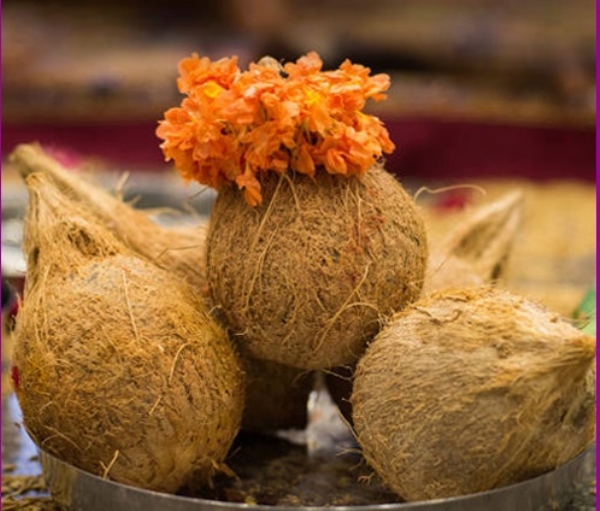
Symbolism: The coconut represents selfless service and the idea of surrendering one's ego. The outer shell represents the ego, while the inner kernel symbolizes the pure, inner self.
Spiritual Significance: Breaking a coconut and offering its contents to Bhagwan Ganesha is a gesture of surrender, humility, and the willingness to let go of one's ego in the pursuit of spiritual progress.
6. Mushika (Mouse):
Bhagwan Ganesha's mount, or vehicle, is a mouse known as Mushika. While not a direct offering, the presence of a small figurine or image of a mouse is often associated with Bhagwan Ganesha's worship.
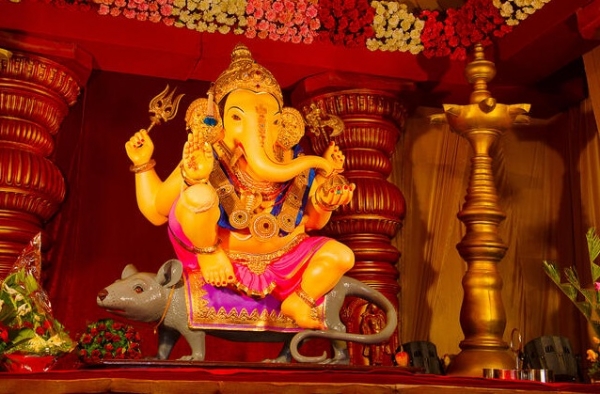
Symbolism: The mouse, Mushika, is traditionally depicted as Bhagwan Ganesha's vehicle. In Hindu symbolism, the mouse represents the ego and desires, which Ganesha has tamed and brought under his control.
Spiritual Significance: The presence of Mushika in Ganesha's imagery serves as a reminder of the importance of controlling one's desires and ego on the spiritual path.
These are some of the traditional items believed to be Bhagwan Ganesha's favorites, and they hold cultural and symbolic significance in Hindu rituals and festivals dedicated to him.
--
